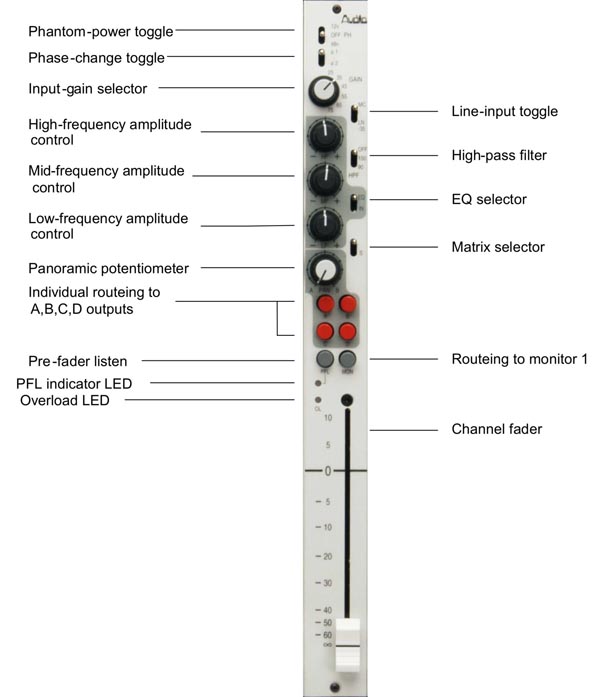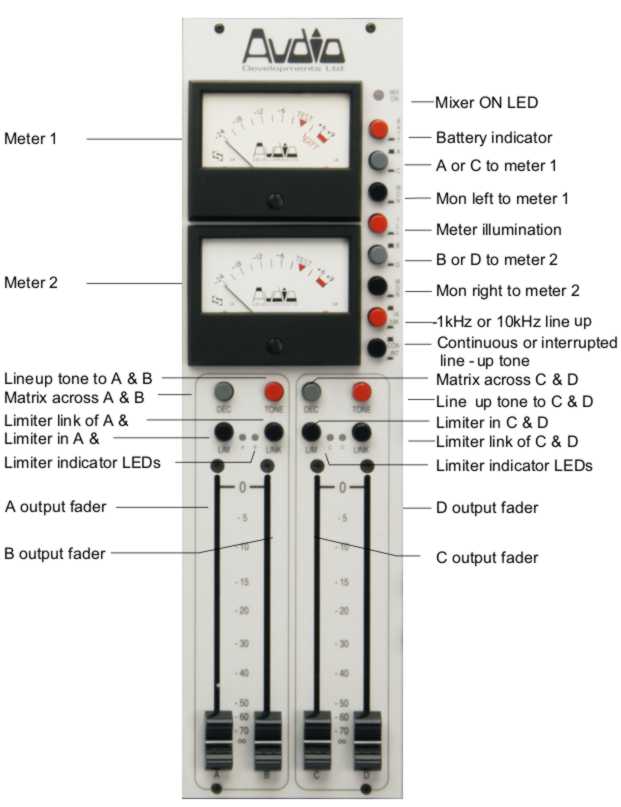AD-146 Pro Mezclador Portátil 6, 8, 10, 12, 18 y 24 Entradas – 4 Salidas
La filosofía de diseño del AD-146 fue crear un nuevo estándar de excelencia tal, que los profesionales de audio dispusieran de un mezclador de suficiente calidad y fiabilidad para permanecer en el mercado por mucho tiempo. Los módulos de línea estrecha hacen que el mezclador sea más pequeño que nunca anteriormente y con sus cuatro grupos de salida se convierte en único. Añadir a esto la tecnología M-S incorporada para grabación y post producción y concluirá que el AD-146 es verdaderamente un mezclador para hoy y para el mañana y refleja los más de 25 años de experiencia y dedicación al audio profesional de esta compañía.
El mezclador está disponible en 6 tamaños, con 6, 8, 10, 12, 18, y 24 entradas, y en cuatro estilos, portátil con asa de transporte, para montaje en Rack de 19” (máx. 10 entradas) y en consola de madera. El nuevo diseño del chasis del mezclador se adapta a todos estos tamaños y formatos y, puesto que todas las conexiones están en la parte superior, son fácilmente accesibles tanto en conciertos como en estudio.
Hay tres módulos de entrada para escoger y pueden colocarse en cualquier posición del chasis: MIC/LINE, MONO LINE, STEREO LINE
- The AD146 inputs, main and auxiliary outputs are transformer balanced on XLRs.
- Separate connectors are used for microphone and line-level inputs: such is the isolation, both input signals may remain connected at all times.
- High-pass filter protects the transformer against low-frequency saturation.
- Headphones and two pairs of stereo auxiliary returns left and right appear on standard jacks.
- A 6-pin XLR carries two-way conversation between the mixer and an Outstation - boom operator or director.
- The AD146 has four mixing busses that enable mixing and/or recording to be performed in the L-R and M-S domains simultaneously. Matrix amplifiers may be switched into the main A-B and C-D outputs.
- The AD146 incorporates the M-S facilities that are now much appreciated by Audio Developments' customers. Many recordists are aware of the advantages Blumlein's M-S microphone techniques have over all other microphone techniques - even when recording in the L-R domain.
- Limiters - which may be linked for stereo operation Limiting is indicated by a pair of LEDs.
- A pair of meters - either PPMs or VUs - may be switched to monitor either the main output or the monitor/PFL output, and battery voltage. The meters can be illuminated.
- The frequency of the internal oscillator is selectable between 1kHz and 10kHz, its output replacing the signal on the main output (TONE).
- The headphone monitor may be switched between main output and tape-return - both with PFL override. The left, right and left + right signal paths may be routed to both contacts of the monitor-output jack.
- Via an internal microphone the operator is able to communicate with the main output (SLATE) and with an outstation (EXT) - from which talkback is available, under logic control.
- The AD146 presents all its input and output connectors on one surface of the case and in-line with the corresponding module. The connector panel is labeled in order that it may be read from the front of the mixer. The integral carrying handle may also be used to support the mixer at a comfortable working angle.
- Powering is provided for 48V Phantom and 12V Tonadermicrophones.
- The mixer receives its power from 10 x C cells fitted internally - the battery housing adding great strength to the casework. Alternatively, power may be supplied from an external 12-15V source.
- The mixer is available in four frame sizes with 6, 8, 10, 18 or 24 inputs.
- REFERENCE 0dB = 775mV at 1kHz unless otherwise stated
- MAX GAIN: MIC 85 75 65 55 45 35 dB / LINE 50 40 30 20 10 0 dB
- MAX INPUT LEVEL: MIC -42 -32 -22 -12 -2 +8 dB / LINE -7 +3 +13 +23 +33 +43 dB / RETURNS +24 dB
- INPUT MIC >1k5R
- IMPEDANCE LINE >10kR
- RETURNS >100kR
- MIC POWERING +48V DC and +12V DC PHANTOM POWER +12V TONADER (to order)
- MAX OUTPUT +23.5dBm (600R LOAD) - A,B,C,D;
- TRANSFORMER BALANCED
- CHANNEL OUT; MON 1 L&R; XLR
- MON 2; UNBALANCED STEREO JACK+18dBm (600R LOAD)
- OUTPUT <60R A,B,C,D;
- IMPEDANCE <20R CHANNEL OUT ; MON 1;MON 2
- FREQUENCY +0; -1dB 20Hz to 20kHz MAIN SIGNAL PATHS
- RESPONSE +0; -1.5dB 20Hz to 20kHz MONITOR SIGNAL PATHS
- EQUALISATION LF; SHELVING ±10dB @ 100Hz VARIABLE TURNOVER MAX ±15dB @ 30 Hz
- MF; PEAK/DIP ±15dB @ 2k8Hz Q = 1.2 RECIPROCAL
- HF; SHELVING ±10dB @ 10kHz VARIABLE SLOPE MAX ±15dB @ 30kHz
- HIGH-PASS FILTER -3dB @ 90Hz and 150Hz, 12dB/OCTAVE SLOPE
- HARMONIC <0.03% @ 1kHz 0dBm OUTPUT
- DISTORTION <0.15% @ 40Hz to 20kHz +15dBm OUTPUT
- CROSSTALK <-70dB 40Hz to15kHz INTERCHANNEL & INTERGROUP / <-55dB 40Hz to15kHz BETWEEN L&R ON STEREO CHANNEL
- NOISE: MIC <-126dB 20Hz to 20kHz 200R SOURCE (WITH RESPECT TO THE INPUT) / LINE >70dB SIGNAL-TO-NOISE RATIO 20Hz to 20kHz
- LIMITER THRESHOLD +8dB
- RATIO 7 : 1
- ATTACK 2ms (SET AT FACTORY) (VARIABLE VIA INTERNAL PRESET)
- RELEASE 250ms (SET AT FACTORY) (VARIABLE VIA INTERNAL PRESET)
- POWERING EXTERNAL AD100-015 POWER SUPPLY UNIT +14V DC, 4-PIN XLR
- 3W (WITHOUT MICROPHONE POWERING)
- Channel direct outputs: This option converts the standard line input XLR connector to a male output XLR connector giving an internally selectable pre or post fader direct output.
- Fader starts: Micro switches added to the input channel faders are wired direct to the 15 pin D socket.
- Variable input gain: A continuously variable gain control replaces the six position rotary gain switch.
- 12 Volt Tonader Mic Power: Replaces the 12 Volt phantom with 12 Volt Tonader Mic power.




